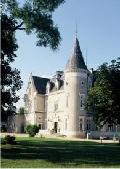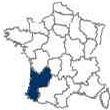|
Bordeaux
Bordeaux is located on a vine covered plain, called the Aquitaine basin, in southwestern France, east of the wine-growing district of Médoc. It is situated on the Gironde River, 15 miles south of the Garonne’s juncture with the Dordogne River where the Girond is formed. Bordeaux is 60 miles southeast of the mouth the Garonne River, on the Bay of Biscay [the Atlantic Ocean]. The town is also linked to the Mediterranean via a canal.
By road, Bordeaux is 356 miles [594 km] southwest by south of
Paris, 116 miles [193 km] south of La Rochelle and 71 miles [119 km] south southwest of
Angoulême. The A10, the A62 and the A630 Autoroutes converge on the city together with the N 10, N 89, N 215, N 250, and the D 106, D 213 and D 936.
The city of Bordeaux is the capital of two administrative districts: The département of Gironde and of the region of Aquitaine. In 1999, the city’s population was 215,363 while the population of the agglomeration exceeded 700,000.
The location of Bordeaux was a settlement as early as the Bronze Age. A Celtic people, known as the Bituriges Vivisci, made it their capital. In the 1st-century BC it fell to the Romans who called it Burdigala and made it the capital of their province of Aquitania, which included the area west of the Roman province of Provence and between the Pyrénées and the Loire River. In the 4th-century AD, the emperor Diocletian divided Aquitania into 3 parts. He made Burdigala the educational center of Gaul, the seat of an archbishopric as well as the capital of Aquitania Secunda. Since Roman times, Bordeaux has been an active port in trading with Spain and England. The decline of the Roman Empire, in the 5th-century, saw the area held by the Goths and the Normans for varying periods. The area around Bordeaux was left politically and economically instable until the 10th-century when the dukes of Aquitaine established themselves.
In 1154, when
Eleanor of Aquitaine’s husband
Henry II [né Henri Plantagenêt] became king of England, Bordeaux, together with the rest of Aquitaine, became an English possession. As an English possession Bordeaux, and the surrounding region [including such towns as Libourne and Saint-Émilion], was given the freedom, from 1235, to elect its own mayors. The area also prospered through a thriving wine trade with England. Bordeaux’s greatest families made fortunes in shipping the celebrated wines of Bordeaux to Great Britain.
France had retaken Gascony and Guyenne from England in 1451. Following Aquitaine’s return to France, ensuing from the Battle of Castillon on July 17, 1453 [the last battle of the Hundred Years’ War between France and England], the French king limited the freedoms that had been given to Gascony and Guyenne by the English. The period from 1548 to 1675 found the Bordeaux a site for revolts against French rule. In 1548, almost a hundred years after the Battle of Castillon, 120 burghers of Bordeaux, who resisted the limitations imposed by the French king on their municipal powers, were executed. During the French Revolution, Bordeaux was a center of the Girondins movement, a moderate Republican faction. During the Reign of Terror, when the Revolutionary French government was in the hands of extremists, severe reprisals were inflicted on Bordeaux.
During the Religious Wars of the 17th-century Bordeaux declined economically and did not prosper again until the commencement of the ‘triangular’ slave trade between Bordeaux, Africa and the West Indies in the 18th-century.
Bordeaux once again suffered during the
Napoleonic wars; this time from the British blockade. It did not recover until the port had been expanded and the railroads had been built. Subsequently, there was increased trade with South America and the West Indies that finally led to prosperity.
In 1870, during the Franco-Prussian War, the French government fled
Paris for
Tours, and then for Bordeaux, when the Prussians neared Tours. During World War I, when the Germans were approaching Paris, the government again departed for Tours and subsequently Bordeaux. And, during June 1940, when the Germans again threatened Paris, the government once again went to Tours and then Bordeaux.
During June of 1940, the French government under Prime Minister
Paul Reynaud, together with General Charles de Gaulle and Georges Mandel, sent appeals to the United States and Great Britain for immediate help. However, a defeatist French opposition overruled them and Reynaud resigned on June 16, two days after the Germans entered Paris.
The Germans blitzed Bordeaux before occupying the town. Because the Germans had airbases and submarine bases in and near Bordeaux, the area was heavily bombed by Allied air forces. During August 1944, Free French forces liberated Bordeaux. Following World War II, Bordeaux has continued to expand.
The Port of Bordeaux
Today, Bordeaux’s 5 miles of crescent shaped quays constitutes France’s sixth largest port. The harbor, which is divided by a bridge consisting of 17 arches called the Pont de Bordeaux, is accessible to oceangoing ships via the Garonne River that flows into the Bay of Biscay. In recent years, city administered satellite ports have been opened, nearer to the sea, to accommodate larger ships. The port is also the home of a large fishing fleet.
Bordeaux is world famous for its wines that mellow, as the bottle grows older. Most of the classical French Bordeaux [Clarets] are shipped through the port. Shipbuilding is also a large industry in Bordeaux and automobiles and trucks are also manufactured there. There are a number of petrol-chemical complexes near the city as well as food processing plants. Aeronautical and electrical equipment and wood products are also manufactured in and around Bordeaux. Other products include hides and skins, rice, cotton and woolen cloth, sugar, fish and vegetables.
The site for Bordeaux is well planned about its crescent shaped center and to the north. There are wide streets, spacious squares and many imposing buildings that are the city’s heritage from the 18th-century. The old town lays to the south with its crooked, narrow streets and numerous 15th-centure style wooden structures. One of the city’s points of interest is an arched gate, called the Porte de Burgundy, which was built during the 18th-century.
The city boasts the ruins of a Roman amphitheatre and some remaining gates of the old city wall. The Esplanade des Quinconces is one of the largest squares in Europe. It contains a monument to the Girondins and imposing statues to Michel de Montaigne [his tomb is at the university of Bordeaux] and Montesquieu [both were graduates of the university]. The nearby Grand Théâtre, which was constructed from 1775 to 1780, has an imposing double stairway and cupola and a statue-topped colonnade. The old Opéra Garnier, in
Paris, is endowed with a similar staircase. The Hôtel de Ville was the former residence of the archbishops. Many valuable old manuscripts can be found at the Bordeaux library.
The city’s ecclesiastical antiquities include two 15th-century bell towers: The Saint-Michel Tower whose spire towers some 357 feet [109 m] into the sky [the tallest bell tower in the south of France] and the Pey-Berland tower, near Saint-André’s Cathedral which was consecrated in 1006. The church of Sainte Croix is a Romanesque style basilica of the 12th and 13th
-centuries. The Church of Saint Seurin dates from the 11th to 15th-century.
Bordeaux is best known for its wine, a business that has had its ups and downs over the centuries due to a capricious demand, weather problems, grape parasites and the ruinous phylloxera infestation of 1869.
The University of Bordeaux
Since Roman times, Bordeaux had been known as an educational center. The University of Bordeaux was founded in 1441 and was confirmed by papal bull during the reign of King Charles VII. The university was politically active and even sent representatives to the great church councils. It was replaced, in 1970, by the Universities of Bordeaux I, II and III, under the 1968 Orientation Act that reformed French education following the riots of May, 1968. The universities are housed in both Bordeaux and near-by Talence.
Bordeaux I, II and III have been structured into study and research units, each having academic and administrative independence. Bordeaux I offers economics, law and science. Bordeaux II specializes in life sciences and medicine. Bordeaux III specializes in classical studies of letters and arts and languages. It also has a technological institute.
|



